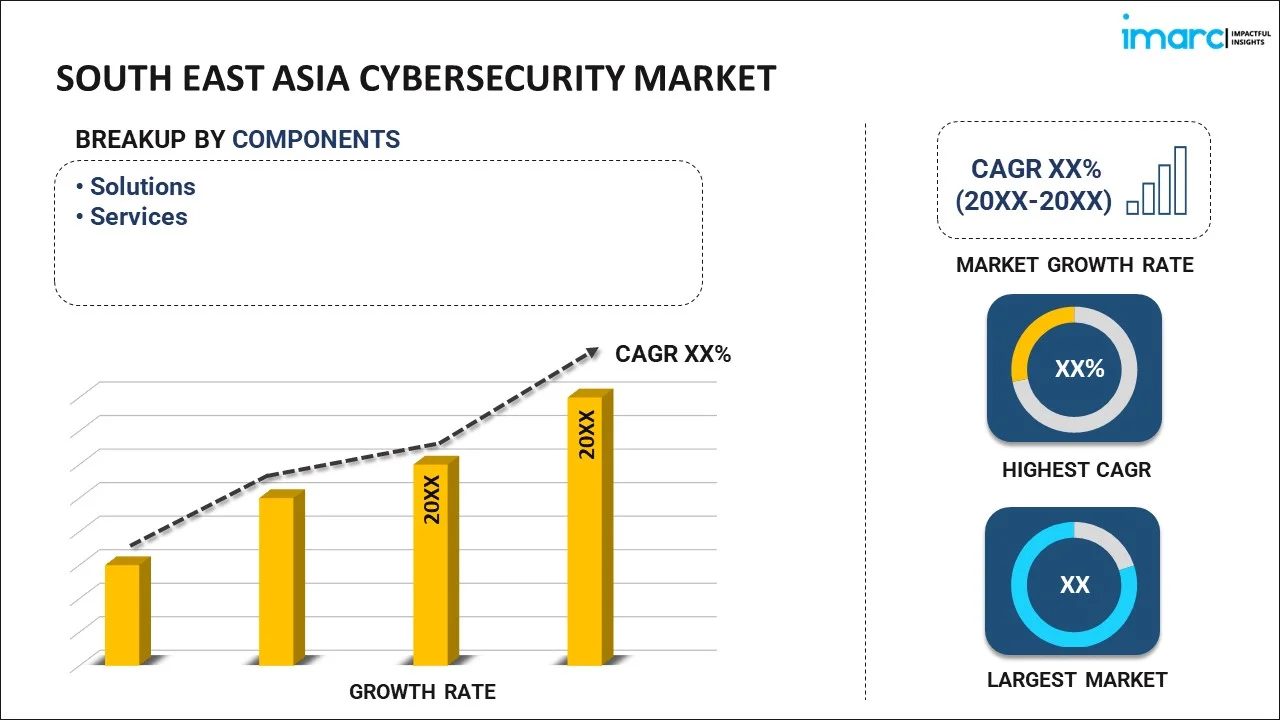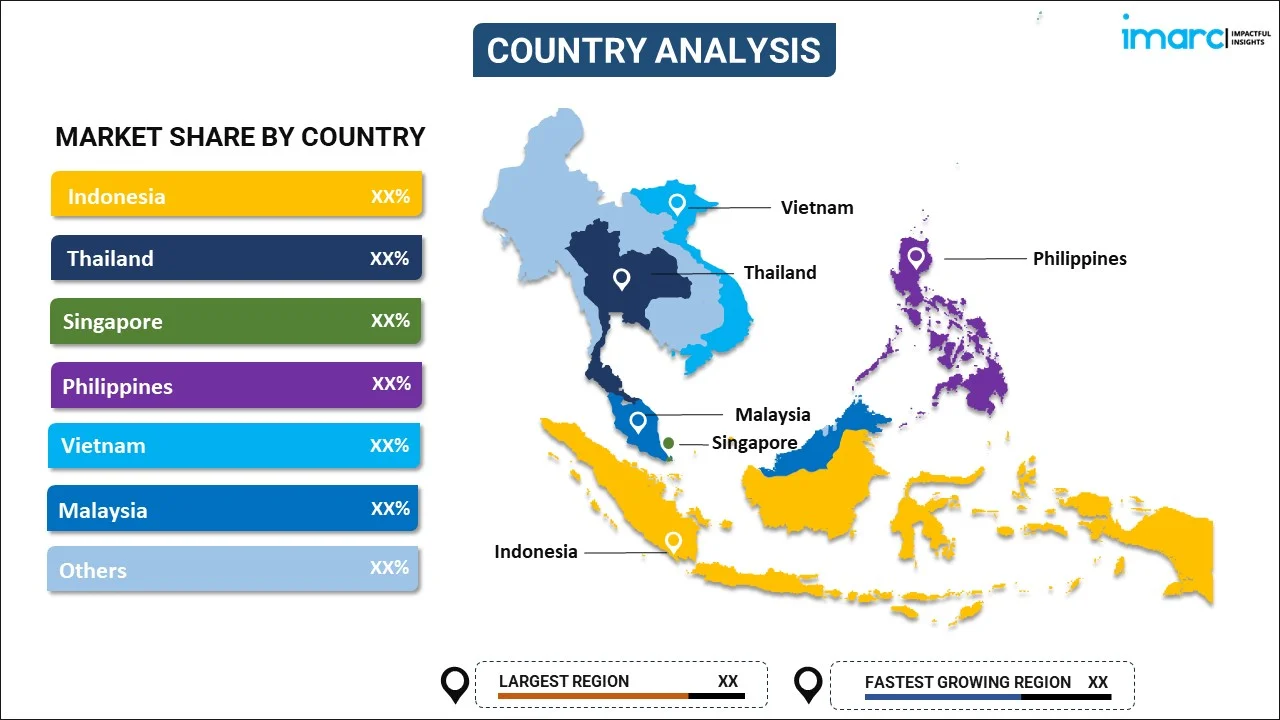
South East Asia Cybersecurity Market Report by Component (Solutions, Services), Deployment Type (Cloud-based, On-premises), User Type (Large Enterprises, Small and Medium Enterprises), Industry Vertical (IT and Telecom, Retail, BFSI, Healthcare, Defense/Government, Manufacturing, Energy, and Others), and Country 2025-2033
Market Overview:
South East Asia cybersecurity market size is projected to exhibit a growth rate (CAGR) of 17.77% during 2025-2033. The rise in the frequency and sophistication of cyber threats, including malware, ransomware, phishing attacks, and other cybercrimes, along with the need for robust cybersecurity measure, is driving the market.
|
Report Attribute
|
Key Statistics
|
|---|---|
|
Base Year
|
2024 |
|
Forecast Years
|
2025-2033
|
|
Historical Years
|
2019-2024
|
| Market Growth Rate (2025-2033) | 17.77% |
Cybersecurity is the practice of protecting computer systems, networks, and data from unauthorized access, attacks, and damage. It encompasses a range of technologies, processes, and practices designed to safeguard digital information and maintain the confidentiality, integrity, and availability of computing resources. Cybersecurity measures include the implementation of firewalls, encryption, antivirus software, and intrusion detection systems to detect and thwart malicious activities. As the digital landscape evolves, cybersecurity also addresses emerging threats such as ransomware, phishing, and advanced persistent threats. With the increasing interconnectedness of devices and the growing reliance on digital infrastructure, robust cybersecurity is crucial to safeguard individuals, organizations, and governments from the potentially devastating consequences of cyberattacks. Regular updates, employee training, and a proactive approach to identifying and mitigating vulnerabilities are essential components of an effective cybersecurity strategy.
South East Asia Cybersecurity Market Trends:
The burgeoning field of cybersecurity in South East Asia is experiencing unprecedented growth, propelled by several key market drivers. Firstly, the escalating frequency and sophistication of cyber threats have prompted organizations to prioritize robust cybersecurity measures. As cyber-attacks become more complex, the demand for advanced security solutions and services intensifies. Moreover, the increasing digitization across various industries has expanded the attack surface, necessitating comprehensive cybersecurity strategies. In tandem with this, stringent regulatory frameworks and compliance requirements compel businesses to invest in cybersecurity to safeguard sensitive data and maintain regulatory adherence. Furthermore, the pervasive adoption of cloud computing and the Internet of Things (IoT) amplifies the need for cybersecurity solutions that can protect interconnected devices and data flows. The interconnected nature of modern technologies underscores the importance of holistic cybersecurity frameworks. Simultaneously, the rising awareness of the potential financial and reputational damages resulting from cyber incidents drives organizations to allocate significant budgets for cybersecurity initiatives. In conclusion, the confluence of evolving cyber threats, digital transformation, regulatory pressures, and heightened awareness collectively propels the dynamic growth of the cybersecurity market in South East Asia.
South East Asia Cybersecurity Market Segmentation:
IMARC Group provides an analysis of the key trends in each segment of the market, along with forecasts at the regional and country levels for 2025-2033. Our report has categorized the market based on component, deployment type, user type, and industry vertical.
Component Insights:

- Solutions
- Identity and Access Management (IAM)
- Infrastructure Security
- Governance, Risk and Compliance
- Unified Vulnerability Management Service Offering
- Data Security and Privacy Service Offering
- Others
- Services
- Professional Services
- Managed Services
The report has provided a detailed breakup and analysis of the market based on the component. This includes solutions (identity and access management (IAM), infrastructure security, governance, risk and compliance, unified vulnerability management service offering, data security and privacy service offering, and others) and services (professional services and managed services).
Deployment Type Insights:
- Cloud-based
- On-premises
A detailed breakup and analysis of the market based on the deployment type have also been provided in the report. This includes cloud-based and on-premises.
User Type Insights:
- Large Enterprises
- Small and Medium Enterprises
The report has provided a detailed breakup and analysis of the market based on the user type. This includes large enterprises and small and medium enterprises.
Industry Vertical Insights:
- IT and Telecom
- Retail
- BFSI
- Healthcare
- Defense/Government
- Manufacturing
- Energy
- Others
A detailed breakup and analysis of the market based on the industry vertical have also been provided in the report. This includes IT and telecom, retail, BFSI, healthcare, defense/government, manufacturing, energy, and others.
Country Insights:

- Indonesia
- Thailand
- Singapore
- Philippines
- Vietnam
- Malaysia
- Others
The report has also provided a comprehensive analysis of all the major regional markets, which include Indonesia, Thailand, Singapore, Philippines, Vietnam, Malaysia, and Others.
Competitive Landscape:
The market research report has also provided a comprehensive analysis of the competitive landscape in the market. Competitive analysis such as market structure, key player positioning, top winning strategies, competitive dashboard, and company evaluation quadrant has been covered in the report. Also, detailed profiles of all major companies have been provided.
South East Asia Cybersecurity Market Report Coverage:
| Report Features | Details |
|---|---|
| Base Year of the Analysis | 2024 |
| Historical Period | 2019-2024 |
| Forecast Period | 2025-2033 |
| Units | Million USD |
| Scope of the Report | Exploration of Historical and Forecast Trends, Industry Catalysts and Challenges, Segment-Wise Historical and Predictive Market Assessment:
|
| Components Covered |
|
| Deployment Types Covered | Cloud-based, On-premises |
| User Types Covered | Large Enterprises, Small and Medium Enterprises |
| Industry Verticals Covered | IT and Telecom, Retail, BFSI, Healthcare, Defense/Government, Manufacturing, Energy, Others |
| Countries Covered | Indonesia, Thailand, Singapore, Philippines, Vietnam, Malaysia, Others |
| Customization Scope | 10% Free Customization |
| Post-Sale Analyst Support | 10-12 Weeks |
| Delivery Format | PDF and Excel through Email (We can also provide the editable version of the report in PPT/Word format on special request) |
Key Questions Answered in This Report:
- How has the South East Asia cybersecurity market performed so far and how will it perform in the coming years?
- What has been the impact of COVID-19 on the South East Asia cybersecurity market?
- What is the breakup of the South East Asia cybersecurity market on the basis of component?
- What is the breakup of the South East Asia cybersecurity market on the basis of deployment type?
- What is the breakup of the South East Asia cybersecurity market on the basis of user type?
- What is the breakup of the South East Asia cybersecurity market on the basis of industry vertical?
- What are the various stages in the value chain of the South East Asia cybersecurity market?
- What are the key driving factors and challenges in the South East Asia cybersecurity?
- What is the structure of the South East Asia cybersecurity market and who are the key players?
- What is the degree of competition in the South East Asia cybersecurity market?
Key Benefits for Stakeholders:
- IMARC’s industry report offers a comprehensive quantitative analysis of various market segments, historical and current market trends, market forecasts, and dynamics of the South East Asia cybersecurity market from 2019-2033.
- The research report provides the latest information on the market drivers, challenges, and opportunities in the South East Asia cybersecurity market.
- Porter's five forces analysis assist stakeholders in assessing the impact of new entrants, competitive rivalry, supplier power, buyer power, and the threat of substitution. It helps stakeholders to analyze the level of competition within the South East Asia cybersecurity industry and its attractiveness.
- A competitive landscape allows stakeholders to understand their competitive environment and provides an insight into the current positions of key players in the market.
Need more help?
- Speak to our experienced analysts for insights on the current market scenarios.
- Include additional segments and countries to customize the report as per your requirement.
- Gain an unparalleled competitive advantage in your domain by understanding how to utilize the report and positively impacting your operations and revenue.
- For further assistance, please connect with our analysts.
 Inquire Before Buying
Inquire Before Buying
 Speak to an Analyst
Speak to an Analyst
 Request Brochure
Request Brochure
 Request Customization
Request Customization




.webp)




.webp)












